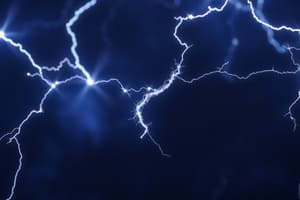Podcast
Questions and Answers
What is the purpose of grounding in relation to charged objects?
What is the purpose of grounding in relation to charged objects?
How does an electroscope indicate the presence of an electric charge?
How does an electroscope indicate the presence of an electric charge?
What occurs during electric discharge between two objects?
What occurs during electric discharge between two objects?
What is the main function of lightning rods?
What is the main function of lightning rods?
Signup and view all the answers
What phenomenon is illustrated by the visible sparks produced when a neutral hand approaches a negatively charged object?
What phenomenon is illustrated by the visible sparks produced when a neutral hand approaches a negatively charged object?
Signup and view all the answers
What happens to an atom when it has more protons than electrons?
What happens to an atom when it has more protons than electrons?
Signup and view all the answers
Which of the following materials is a good conductor of electricity?
Which of the following materials is a good conductor of electricity?
Signup and view all the answers
What is static electricity primarily caused by?
What is static electricity primarily caused by?
Signup and view all the answers
How does charge separation occur in a neutral object when exposed to a charged object?
How does charge separation occur in a neutral object when exposed to a charged object?
Signup and view all the answers
What effect does humidity have on static charge dissipation?
What effect does humidity have on static charge dissipation?
Signup and view all the answers
Which method of charging involves direct electron transfer by touching two materials?
Which method of charging involves direct electron transfer by touching two materials?
Signup and view all the answers
What role do semiconductors play in electronics?
What role do semiconductors play in electronics?
Signup and view all the answers
Which of the following statements about insulators is true?
Which of the following statements about insulators is true?
Signup and view all the answers
Study Notes
Atomic Charge
- Protons define an element's atomic number and cannot be changed within an atom.
- A neutral atom has equal numbers of protons and electrons.
- A positive charge occurs when an atom has more protons than electrons.
- A negative charge occurs when an atom has more electrons than protons.
- Objects gain or lose charge through electron transfer, creating static electricity.
- Most everyday objects are neutral. Contact between differing materials can lead to charge transfer.
Static Electricity and Interactions
- Static electricity is an imbalance of charge on an object.
- Unlike charges repel; like charges attract.
- Attraction/repulsion force depends on charge amount and distance.
- Induced charge separation occurs when a charged object nears a neutral one. This causes electron shifts, resulting in attraction or repulsion without contact.
Conductors and Insulators
Conductors
- Conductors allow electron movement, facilitating electric current flow.
- Good conductors, like copper, aluminum, and gold, facilitate easy electron movement, ideal for wiring.
- Semiconductors allow electron movement with resistance. They are crucial for electronics.
Insulators
- Insulators prevent electron movement; electrons are tightly bound.
- Common insulators include plastic, wood, and paper –protecting against electric shocks, often used to cover wires.
Charging Methods
Charging by Contact
- Charging by contact includes friction and conduction.
- Charging by friction involves rubbing two objects, transferring electrons. This creates a negative charge on one object and a positive charge on the other.
- In humid conditions, charges dissipate more quickly, while in dry conditions, charges remain for longer.
Grounding
- Grounding removes excess charge by transferring electrons between an object and the ground.
- A positive charge gains electrons from the ground. A negative charge loses electrons to the ground, neutralizing it.
Electroscopes and Electric Discharge
Electroscope Functionality
- An electroscope detects electric charge, using a metal sphere and leaves.
- Charged objects touching the sphere transfer electrons affecting the leaves, causing repulsion (negative charge) or attraction (positive charge).
- Charging by induction happens when a charged object nears the electroscope without contact.
Electric Discharge Phenomena
- Electric discharge occurs when objects with differing charges contact or are close. This results in electron transfer.
- Rapid charge transfer creates visible sparks. Charge equalization results from a neutral hand approaching a charged object.
- Lightning is a large-scale electric discharge between clouds and the ground.
Lightning and Safety Measures
Lightning Rods
- Lightning rods are conductive metal structures used to prevent damage from lightning strikes.
- They attract negative charges from clouds, providing a safe path to ground.
- Lightning rods prevent electrical surges damaging properties.
Studying That Suits You
Use AI to generate personalized quizzes and flashcards to suit your learning preferences.
Description
This quiz covers the fundamentals of atomic charge, including the roles of protons and electrons in defining atomic structure. It also explores static electricity, including the behavior of charges, interaction forces, and the distinction between conductors and insulators. Test your understanding of these key concepts in electricity and materials.




